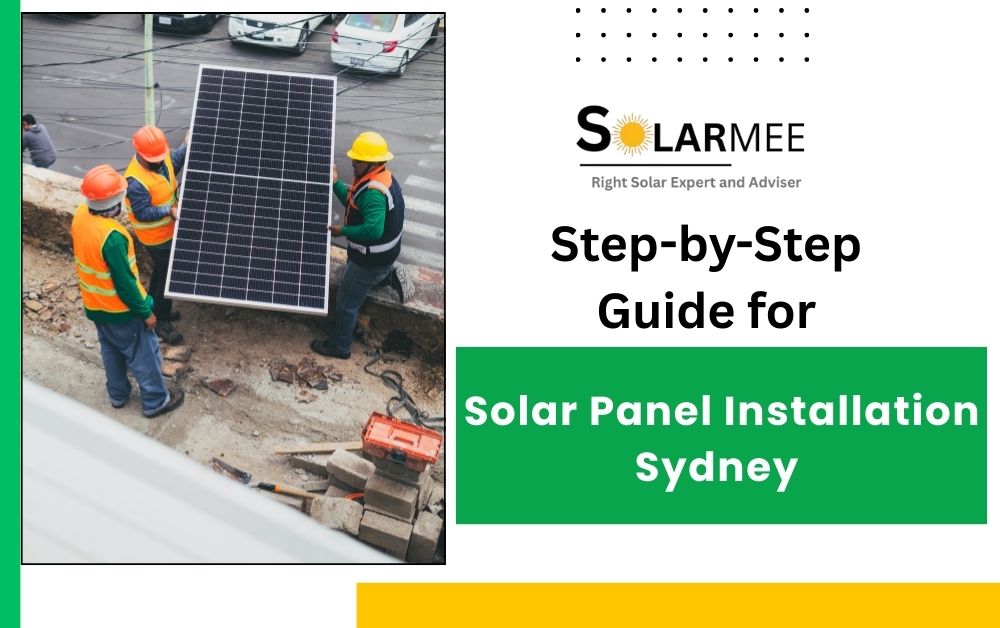Its sun-drenched climate and government assistance mean that it’s becoming one of the solar capitals of the world. Sydney, with its approximately 2360 hours of annual sunshine, is going solar to lower expensive energy bills and meet sustainability targets for both homes and businesses. The city has advanced technology and financial incentives in its favor, as well as a growing public fascination with green living.
With increasing demand for solar panel installation in Sydney, a lot of people want to learn how to make the transition responsibly. This solar panel installation guide will cover the key steps to have solar panels installed at your home or business.
It features useful tips, advice, and reviews to guide Sydneysiders towards smart decisions about their energy future. Even if you are new to solar or looking to crossgrade, this guide will help you understand and plan better.
Understanding Solar Panel Installation Basics
When setting up solar panels, you are acquiring a system that converts sunlight into electricity that can be used for your home and/or office. The installation process entails assessing the viability of your roof, the design of the system, approvals and permits, installing the system (including the panels), any wiring to the inverter, wiring of the inverter to your electrical supply – generally the electrical grid (this step is sometimes referred to as site commissioning). As the installation of solar panels is being completed, there will be an experienced, qualified person ensuring safety in the installation and in maximizing efficiency.
There are two main types of systems: residential or commercial. Residential systems are usually smaller, having been designed for the needs of a single-family home, and typically are concerned primarily with reducing electricity costs. Commercial systems are usually larger systems installed on office buildings or factories, with higher energy outputs to meet higher electrical needs. An important consideration for both types is the ability of the roof to support the installation of solar panels.
Several different factors contribute to the effectiveness of solar generation – shading from trees or nearby buildings, roof orientation (roof slopes facing north in Sydney and the Southern Hemisphere receive the most sunlight to produce energy).
Understanding the process of installing solar panels provides you with some knowledge of what to expect when undertaking a solar project. You want a system that works for your property; it is the process of transferring sunlight into usable, clean, renewable energy. The process contributes to taking steps towards monetary savings and sustainability values, which is ‘a step in the right direction’.
This brief description covers what a solar panel installation means, describes the residential and commercial system installations, and provides some considerations for trying to make the best decisions when approaching an installation.
Also Read: Solar Power Government Rebate Sydney
Why Solar Power is Booming in Sydney
Sydney’s growing interest in solar energy is mostly attributable to a mix of government support, lower pricing, and eco-friendly benefits. The NSW and federal governments put out rebates and incentives like the Small-scale Technology Program (STC), which in turn lowers the price of solar panel installation at least for the up-front cost, thus making it a go for Sydney home and business owners.
Also, we have feed-in tariffs which enable people to make a profit from the energy they put back into the grid. That which does it for many is the money factor. Solar panels may not look like an immediate cost-effective solution, but in the long term, they do in fact reduce your electricity bills.
In addition to cost savings, what we are seeing is that many Sydneysiders are going solar for energy independence, which is a plus as we see electricity prices rise. Solar panels produce clean, renewable energy, which in turn reduces our dependence on fossil fuels and, at the same time, reduces the city’s carbon footprint.
Also, with its abundant sunshine, which we have in Sydney, we see very reliable home and business power from solar, which in turn we see as a step toward sustainability. We are also seeing a growth in solar use (we are at about 30% of homes), which in part is due to reports and policies that are in play that push for solar on new builds to hit NSW’s net zero by 2050. Thus, solar is not only a smart financial move but also a great play for the environment and energy security in Sydney.

Step-by-Step Solar Panel Installation Guide
Step 1: Site Assessment & Energy Audit
The first thing that a good installer would do is to do a site assessment. He or she will examine the size of the roof, the tilt, and the amount of sun it receives during the day. Shading of trees, surrounding buildings, and even chimneys is thoroughly inspected since shade will actually reduce the amount of energy you are going to produce.
They will also inspect your energy bills to check your power consumption, hence the system is adjusted to the required size. It is all about determining how realistic your roof is and how much electricity you use.
Step 2: Choosing the Right Solar Panel
| Type | Efficiency | Price | Durability | Best for Sydney |
| Monocrystalline | High (18-22%) | Higher | Best | Yes—Good for rooftops |
| Polycrystalline | Medium (15-18%) | Medium | Good | OK, but less efficient |
| Thin-film | Low (10-13%) | Lower | Fair (portable) | Not ideal for homes |
The best option in Sydney would be monocrystalline panels. They are effective, they do not occupy a lot of space, and they easily cope with the sunshine in Sydney.
Polycrystalline panels are less expensive but do not generate as much power within the same area, hence they are mostly applicable in large roofs or in large budgets. Thin-film panels are flexible and cheap, but due to their low efficiency, it does not suit the homes in this region.
Step 3: Designing the System & Getting Permits
This is the process in which things are mapped out. The installer will agree on the most appropriate size of the system, i.e., 6.6kW in case of a family home, and the inverter to suit your total panel output. In case of battery backup (to operate at night with the help of solar power), this is also included in the design.
The typical rooftop solar installations used in most houses in Sydney do not require formal approval through the council, but you may be required to do so in case your home is listed as heritage or in the case of other distinct features. Consult the local council, and the installer would usually provide permits and applications to connect to the grid.
Step 4: Installing Mounts & Panels
After the paperwork, installers attach metal mounts to the roof. To have the maximum results in Sydney, the panels are tilted and angled to face north-this will give the sun more energy over the year.
The mounts must be super strong to embrace the wind and storms. When a roof is tiled, it may require some cutting or grinding of brackets, but when installed by the installers, it will be made watertight. Next, the panels are attached to the mounts, and they are spaced evenly to ensure optimal functionality.
Step 5: Wiring & Inverter Connection
After that, the installer attaches the panels with special wiring that is capable of withstanding heavy sun and weather. All these wires push up to the inverter, a device that converts the solar energy on the panels to the type of electricity consumed in a home. The safety here is a major concern, and these issues are addressed with extreme precautions and electrical requirements being adhered to so as to ensure that everything is safe to handle.
Step 6: Grid Connection & Testing
Then, all is connected to your home electric switchboard and, should you wish, to a solar power battery. The installer does testing to ensure that nothing goes wrong and nothing is unsafe.
In the event of being connected to the grid (so you can sell additional power to get credits or rebates), there will be a final check by the government or energy distributor. After passing the system, it is willing to turn on, and you can begin using clean and solar power daily.
Costs of Solar Panel Installation in Sydney
Solar panels will cost approximately 3,500 to 5,000, 4,500 to 7,000, and 8,000 to 13,000 to install in Sydney in 2025, depending on the system size, the amount of rebates available, and whether the panels have a battery or not. These are the prices of a complete installation and include the basic and the premium. A 5kW or a 6.6 kW system is the most common household system in Sydney, and it is the most suitable one depending on the household’s power consumption and the fact that it allows the household to save greatly on the bill as time goes by.
What Makes Up the Price?
To start with, there is the issue of brand and quality. Such established brands as LG or SunPower are more expensive but may last longer and generate more energy. Lower-priced brands may save some initial outlay, but may wear out.
Then, there is a difference in the roof. When the house is a one-storey building with a metal roof, it can be fitted more easily and cheaply. Aged or sloping roofs, or with awkward angles and numerous shady recesses, complicate the work and increase the price a wee bit.
And naturally, the installation choice of the company is also important. These trusted installers cost more but often provide more warranties, fittings of a safer kind, and the actual confidence that they really know what is on the roof.
Tips to Keep in Mind
- Request quotes from a few local installers and then decide- prices do vary greatly between them.
- Federal government rebates, which in many cases reduce the cost by thousands, should not be forgotten.
- When a price appears too good to be true, review price warranties and check. One should not mind spending a little more to have a well-done job and equipment that will last for years.

Choosing the Best Solar Panels & Installers in Sydney
This is a brief preview of what I am going to write about the answer:
- The LG, SunPower, Jinko, and Canadian Solar are the popular brands in Sydney.
- SunPower panels have been mainly characterized by high efficiency (approximately 22.8 percent), long warranties (up to 40 years), and excellent heat and shade performance.
- Jinko and Canadian Solar are reputed to be of good efficiency, cost-effective, and strong warranties.
- The certified installers must be accredited under CEC (Clean Energy Council) and have good customer reviews with extensive warranty and after-sales services.
- The best installers of solar in Sydney, such as Esteem Energy, Better Call Solar, and Solar Concepts, have a high rating on professionalism and customer satisfaction.
At this point, I am going to prepare the solar panels and installers in Sydney comparison table and the review. Solar Panels: Sydney installation: Reviews and best panels and installers.
The most suitable solar panel brands in Sydney would be those that combine warranty, endurance, and efficiency. LG performs well and has a stable brand loyalty. Jinko and Canadian Solar are the best in case one desires quality panels at a relatively affordable cost.
| Brand | Efficiency (%) | Warranty | Key Strengths | Customer Feedback |
| SunPower | 22.8 | 40 years (performance + product) | Highest efficiency, excellent heat and shade tolerance | Very positive, praised for long-term reliability and clear energy gains |
| LG | Around 21 | 25 years (product + performance) | Trusted global brand, great tech, and performance | Positive reviews, valued for consistent energy output and build quality |
| Jinko | 19-21 | 25 years | Affordable, reliable, good value for the Sydney climate | Generally strong, especially for cost-conscious buyers |
| Canadian Solar | 19-21 | 25 years | Good balance of cost and performance, common in Australian installs | Good reviews citing decent efficiency and reliability |
Selecting the correct Installer in Sydney.
Find installation contractors that have Clean Energy Council (CEC) accreditation. This implies that they comply with the Australian standards and are eligible for rebates. Esteem Energy, Better Call Solar, and Solar Concepts are considered to be the top installers that have received a high rating in terms of being professional, having neat installations, and providing after-sales services to customers.
Installers: suggestions on how to find one:
- Check CEC certification and make them warranties and workmanship guarantees on the systems.
- Read several reviews of customers with respect to the quality of installation and responsiveness to service.
- Obtain prices from a number of installers to compare prices and system designs.
- Inquire about after-sales services and monitoring.
Maintenance, Insurance & Lifespan of Solar Panels
It is not that hard to maintain your solar panels in good condition in Sydney, provided you take a few easy steps. Clean the panels at least once every 3-6 months, with only water and a soft cloth or sponge; otherwise, you can easily scratch the glass. Avoid using harsh chemicals and avoid using high-pressure hoses.
Making the panels difficult to access, then it is better to hire people in to do a task like that, check the system briefly to see if it is dirty, shade, or any other evidence of damage, cracks, loose wires, and strange mounting, etc., then whenever you can.
In case you find that your energy production is decreasing or the inverter is displaying warning lights, then do not delay and make a phone call to a technician. It is a good idea to have a once-a-year complete pro inspection to identify problems at the earliest stage of their existence and ensure that all is running smoothly.
The majority of solar panels have a lifespan of 2530 years, although they are not resistant to the sun and weather in Sydney. The efficiency of a panel decreases approximately 0.5-1 percent annually and, hence, at the end of 25 years, the panels will still be operating, only at a reduced rate compared to when they were initially installed. The performance warranty of most manufacturers on their panels is 20-25 years.
On the issue of insurance: home insurance is typically covered in Sydney; however, it is always a good idea to ask the insurance company whether rooftop solar panels are covered under the policy or not, and whether or not the policy covers storm, hail, or accidental damage.
In case the solar panels are not listed, request your insurer to include them in the policy to be able to repair or replace them. It can also save any insurance claim you have to make faster and stress-free by keeping a record of your solar system, including receipts and serial numbers.
Also Read: Step-by-Step Guide for Solar Panel Installation in NT (Northern Territory)
Conclusion:
Installation overview: The installation process consists of several stages:
- Site evaluation and planning: Survey roof structure, shading, and exposure to sunlight.
- Get permits and approvals: Find out local Sydney rules and grid connection rules.
- Choose solar system elements: panels, inverters, mounting equipment, and optional battery storage.
- Install mounting equipment: Mounts should be firmly attached to your roof, making sure that they are durable and properly aligned.
- Install and fix the solar panels on the mounting brackets in a cautious manner.
- Electrical installation: Hook up panels to the inverter and home electrical system.
- System testing and inspection: Make sure that all is operational and safe.
- Connect to the grid: Final grid-tied systems involve the setup of the activation and monitoring.
Final thoughts:
Placing solar panels in Sydney will make vast savings in electricity bills, or even more importantly, increase the value of your home. The sunny climatic conditions in Sydney ensure it maximizes the production of sustainable energy to reduce your carbon footprint and ensure long-term environmental benefits.
Solar systems are independent of energy and pay back fast, and in most cases, in a few years, and the cost of maintenance is minimal. It is always good to visit an installer of solar systems before you make the decision, so that the installer can assist in making the correct choice of system and ensure a safe and efficient installation that meets your needs at home.
The advantage of this solar panel installation guide is that it shows the cost-saving, sustainability, and value-added solar energy can bring to Sydney homeowners. Using professional advice will ensure you have a peaceful mind and is going to produce the best out of your investment.

“Hi, I’m Ishita ,a content writer who loves turning ideas into engaging stories. I specialize in writing blogs, articles, and website content that connects with readers. Over the past few years, I’ve worked with startups and companies to create clear, creative, and impactful content. When I’m not writing, you’ll usually find me reading or exploring new ideas for my research. This website is my space to share my work and connect with people who value quality writing.”




